Saphenion®: Memories of Sauerbruch-My „Sauerbruch“-Déjà-vu
Saphenion®: Memories of Sauerbruch – It was the summer of 1969 when I was 9 years old and had to undergo an operation in the Rostock University Clinic. The surgeon, Senior Physician Smolinski, spoke to me before and after the operation in a very friendly and affectionate manner, which I felt as a child – very empathetic. Today this is called empathy. In any case, I was deeply impressed by Senior Doctor Egon Smolinski and after the successful operation I said out loud in my parents‘ car what I was already thinking about in the hospital – I will become Senior Doctor Smolinski!
Now at the age of 9, there are certainly still one or the other possibility of choosing a career, but for me, the drop was almost sucked – I wanted to become a surgeon. For my birthday and for Christmas I would like biographies of well-known doctors. On the table of gifts were books about Albert Schweitzer, Robert Koch, Ignaz Semmelweiss, Louis Pasteur, Joseph Lister, Max von Pettenkofer, Albrecht von Graefe and a few others. Sauerbruch was not there. In an interim phase between the ages of 13 and 15, I deviated a little, because as a competitive athlete in the row – double fours were quite successful in GDR times. The jump to the KJS (sports school) was denied to me, why, that should only be shown in 2008, when my first son went to the sports school of SC Magdeburg handball.
In this situation, my parents told me why I hadn’t ended up at the KJS (sports gym)… So the desire to become a „surgeon“ became a constant thought.
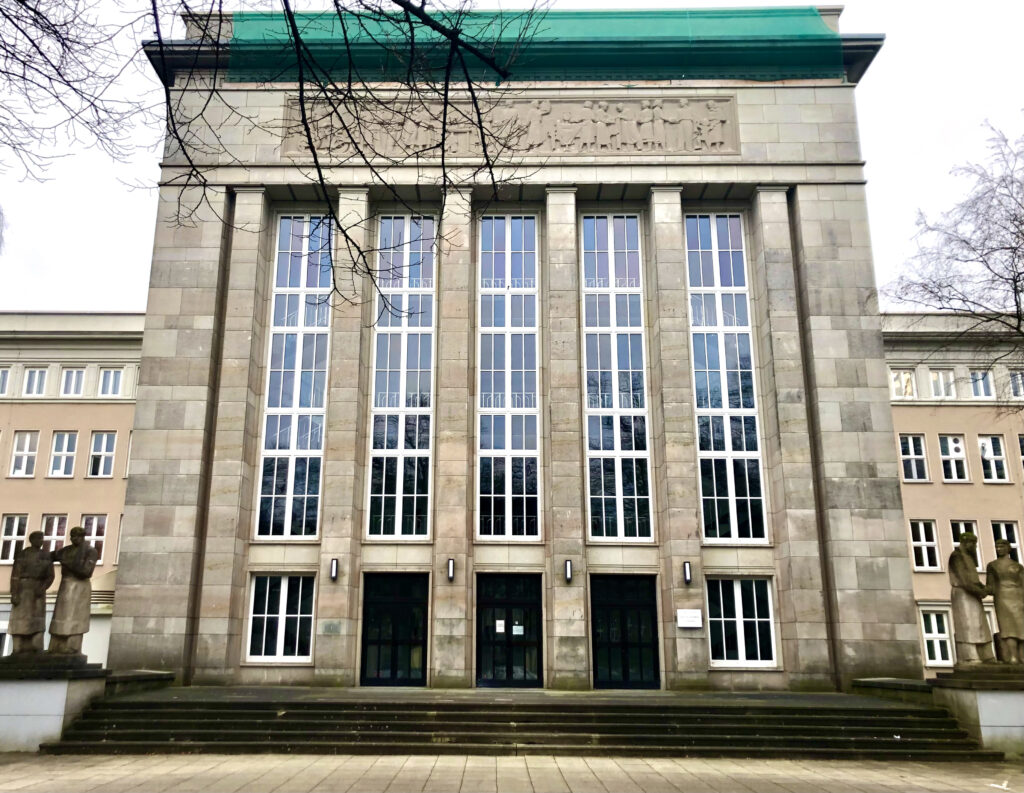
Saphenion®: memories of Sauerbruch – first thoughts about Ferdinand
In 1977 my parents moved from Rostock to Berlin, I finished 10th grade at the Herder-EOS in Rostock and then drove afterward. A nurse from the Charitè Surgical Clinic lived as a neighbor in our house near Alexanderplatz. She recommended that I do a student internship in the surgical operating room, as I had so vehemently announced my career goal at a social gathering.
She paved the way for me to see Ilse de Maiziere, the head nurse in surgery (ex-wife of Lothar de Maiziere). After a somewhat longer conversation, I got (for the first time a student) an internship in the Sauerbruch operating theater, a large operating room with 5 operating tables and a glazed balcony for students. I was responsible for transporting the patients to and from them and moving them from the trundle bed to the respective operating table. Most of my time, however, I devoted to watching abdominal, vascular, cardiac, and neurosurgical operations. I was impressed by a young senior physician in vascular surgery, Dr. Klaus Bürger. It was also very interesting with the new head of the house, Prof. Helmut Wolff – the name von Sauerbruch was mentioned several times. So I bought Wolfgang Genschoreck’s Sauerbruch biography at the Alex in the bookstore – and read it through in one night.
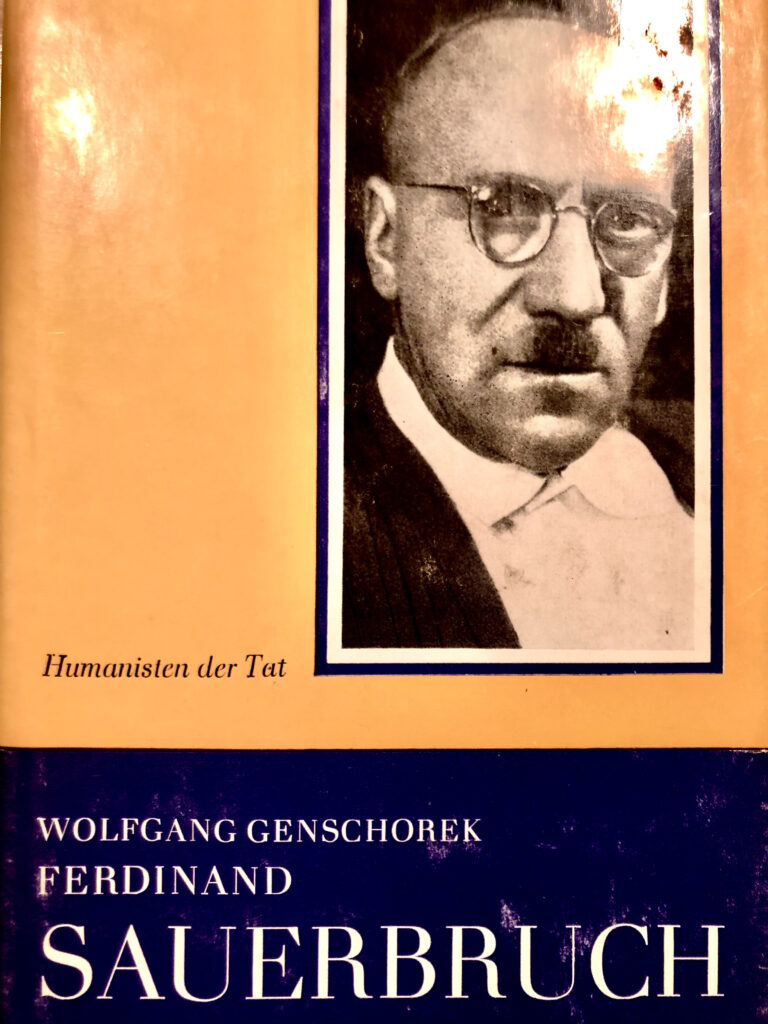
Saphenion®: Memories of Sauerbruch – Studies at the Humboldt University – Sauerbruch House, Sauerbruch Hall, Sauerbruch OP
Then passed high school in 1979, 3 years in the army as a medic and medical trainer, while doing the medical Latinum and got the driver’s license. The beginning of studies in 1982 at the Humboldt-Uni / Charitè. The name Sauerbruch comes up again and again, in the lecture room, in the operating room and the old surgery clinic building also bears the name. He was omnipresent and was highly revered in the GDR. However, my interests lay in the field of vascular surgery, so I came to the current Prof. Klaus Bürger, where I wrote the diploma thesis on „High aortic occlusion“ „and then the doctoral thesis on“ Thrombosis prophylaxis and therapy at the Charitè Clinic „. Here, for the first time, aspirin / ASA was critically questioned as a venous thrombosis prophylactic in a scientific paper by the Charitè. Until then, it was considered a panacea.
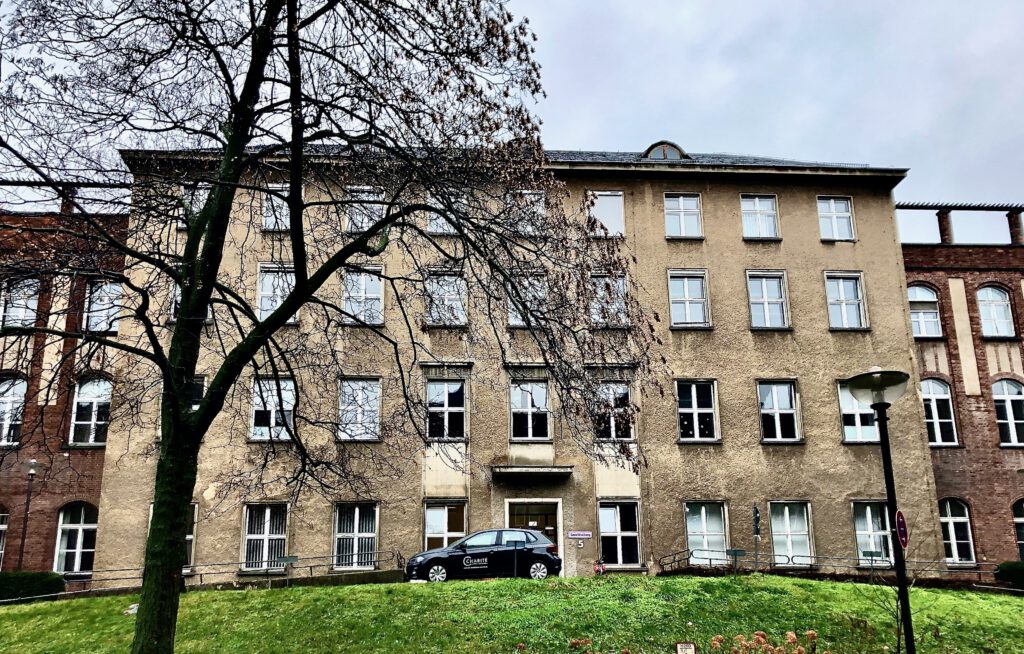
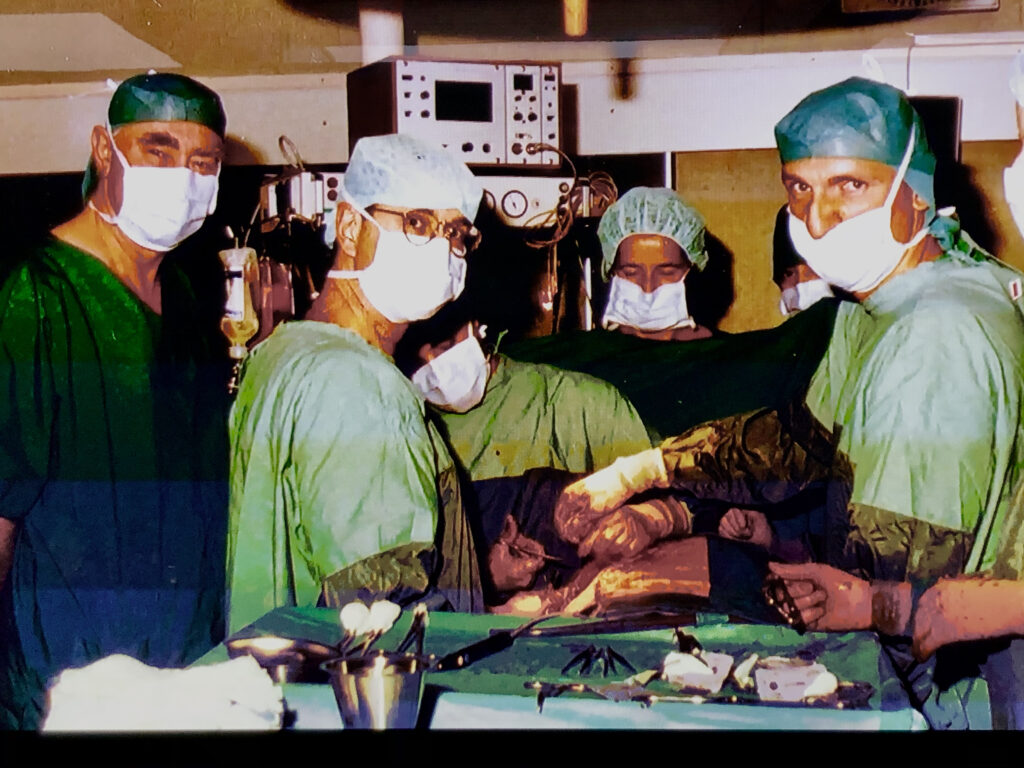
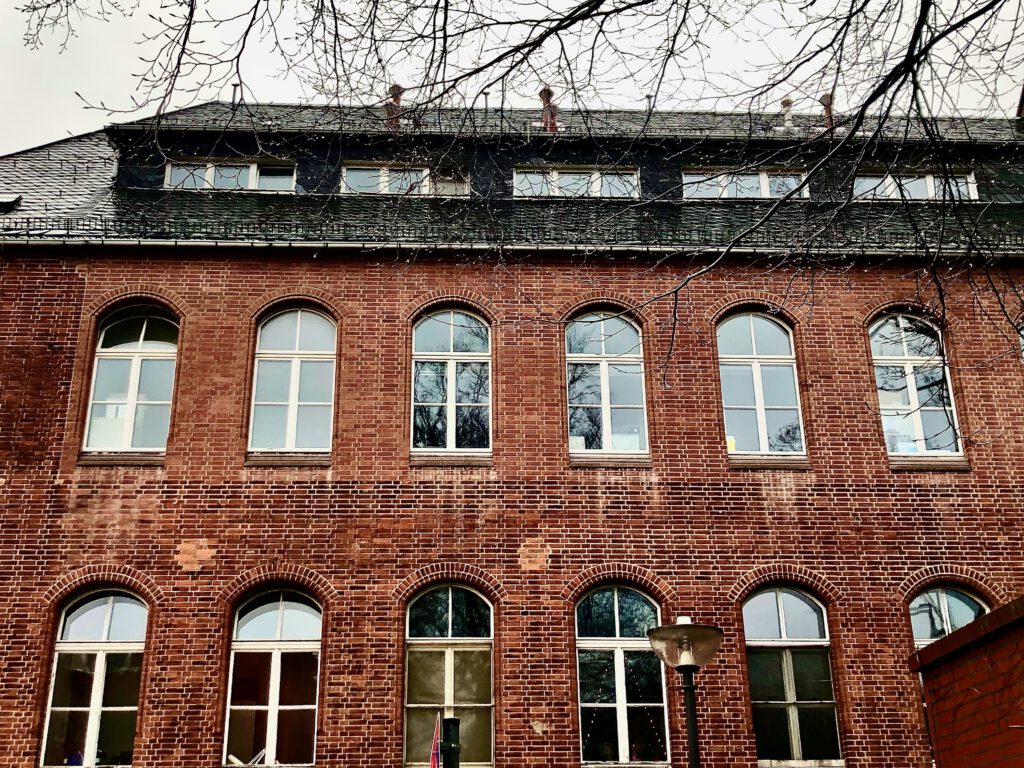
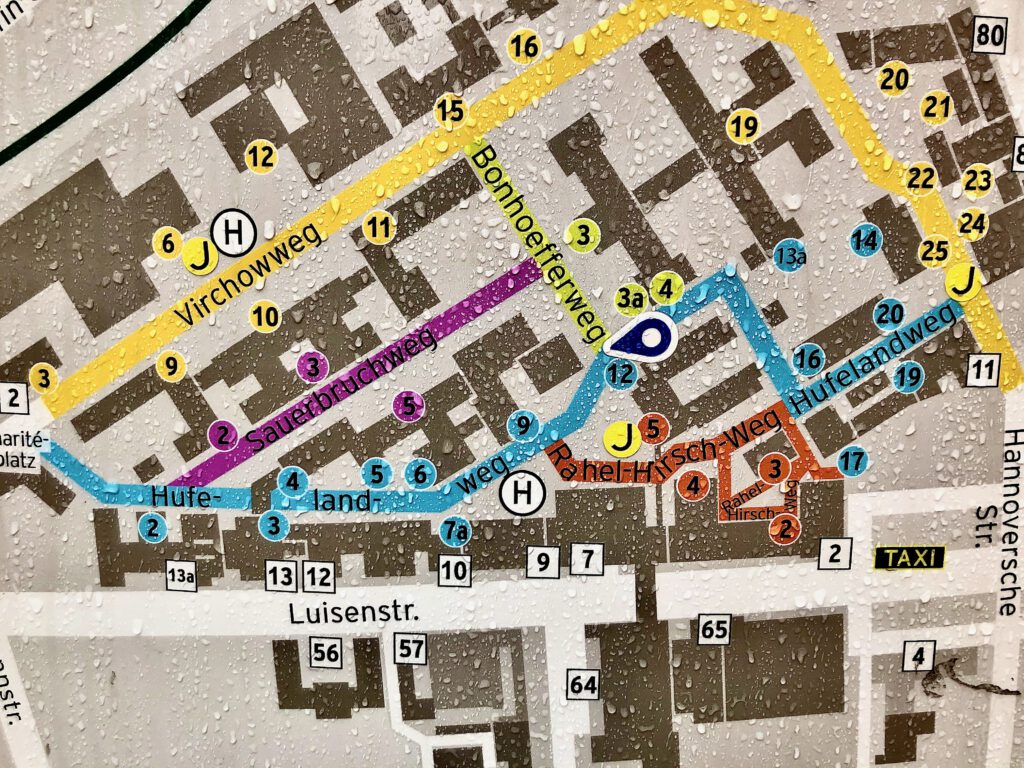
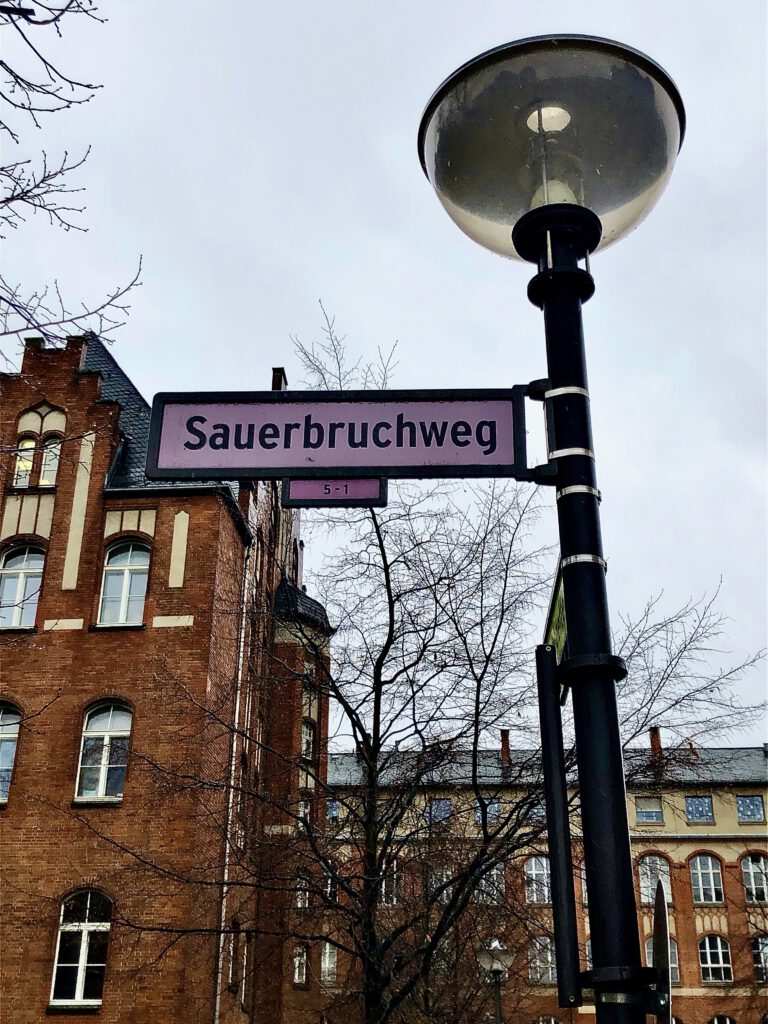
Prof. Bürger knew my interest in vascular surgery and often asked me to go to the vascular surgery operating room – now in the new building – the Charitè high-rise. A habilitation in this area was also planned. But first, the specialist in surgery had to be passed. 4 years of work in the operating room and in the polyclinic, intensive care medicine, and rescue center. And then the wall came down – and everything was different.
On 11/10/89, very early in the morning, I sat on the west bank of the Spree and looked over to the Charitè – and began to cry. Because it was clear to many of us that medicine in the form we had learned would no longer exist in the future.
And that’s right, 2 of the clinic’s 96 surgeons stayed at the house. All others looked for new ways or were „asked“ to leave the house. This first affected the professors, then the senior physicians, and then the specialists. And so I left the now highly politicized house (although I could have stayed with Prof. Bürger) and looked for a renowned vein clinic – in Malente (Schleswig Holstein). Then followed a year at the 2nd University Clinic in Cologne, then the examination in vascular surgery and the move to Gransee (I wanted to go back to the family and my first son, who was born in the meantime). Here I was able to set up my own vascular surgery and began with catheter therapy.
But after 18 months the beautiful dream was over, the clinic was sold and converted into a rehab facility. The only thing left was to do something of my own.
Saphenion®: memories of Sauerbruch – in my own practice far away from Ferdinand
From February 1997 in our own practice, so you have a lot to do and there is no time to delve into the biographies of colleagues. Clueless about the system, clueless about the technical and financial requirements, it first took me 4-5 years to even find my way around the new system. Then I got help from an old colleague from the Charitè times, one of my reviewers for my doctoral thesis, Privatdozent Wolfgang Lahl. And finally, they started again to get some scientific information and to write one or two articles together with PD Lahl. But nothing with Sauerbruch. Ferdinand was very far away and was not part of our daily thinking.
Thanks to our many years of experience with vascular catheters, it was not that difficult for us to introduce them to the therapy of venous diseases and to improve our technical skills. First, it was the laser catheter, then the radio wave catheter, and the micro-foam therapy, and then from 2012, it started with the vein glue. After 2 years of familiarization with this concept – a completely new concept for varicose vein therapy (that’s how we thought at the time) – we began to modify the method, expanded the indications and accelerated the therapy processes. And we were able to write a few scientific articles – it was again a nice, exciting and very varied time.
And the idea grew in us to do a little historical work on the subject of minimally invasive varicose vein therapy, and so we began with the necessary research in the specialist literature. So we were all the more surprised when we discovered that the idea of gluing wasn’t all that new. And now PD Lahl told – rather casually – that until 1968 he had also worked with glucose solutions. This is exactly what we found in our research and this is exactly what led us back to Ferdinand Sauerbruch. Admittedly, it was more of a coincidence, and admittedly, a very small star in the big sky of surgery, but still very interesting and belonging to the present day.
Saphenion®: memories of Sauerbruch – no more radical vein surgery in 1930
After the successful introduction of the vein glue into our everyday practical work, we decided in a collegial agreement to forego the classic therapy method of pulling out varicose veins (stripping, phlebectomy) once and for all – apart from absolute emergencies. So the venous catheter was fully integrated into our practical work from 2012, knowing full well that this was not a service supported by the health insurance companies. Fortunately, there were and are many patients who are well informed and who also think outside the box. Thus, after an initial financial bottleneck, an increasingly balanced relationship with a number of satisfied patients developed.
And then we read during our specialist book research that Ferdinand Sauerbruch was giving his inaugural lecture at the Charitè Berlin at the end of 1927 and also got into conversation with a senior physician at the clinic, Georg Bierendempfel. From 1927 onwards, Bierendempfel had treated the varicose veins with a high-percentage glucose solution – in the practical sense a forerunner of catheter therapy with vein glue. Sauerbruch looked at this therapy with great interest but emphasized that he would like to see long-term results.
He received this in 1930 and was so positively surprised that, with his well-known impulsive character, he immediately prohibited any further radical surgery for all surgeons at the Charitè and established minimally invasive glucose injection as the therapy of the first choice. In other words, a gentle procedure without incisions and with the effect of sealing veins. This non-spontaneous, rather well-considered approach was then copied at 10 other university hospitals in Germany by 1933. And it moved into the “textbook of surgery”, founded by Ferdinand Sauerbruch. Finally, it should also be written that Sauerbruch had also carried out radical surgical interventions as early as 1910 and was also known and exchanged with many experts in varicose vein therapy in his time.
Therapy with sugar solutions was still practiced in the GDR until the mid-1960s – PD Dr. Wolfgang Lahl told me about it – radical pulling out was again the first choice therapy in the FRG from 1949 onwards.
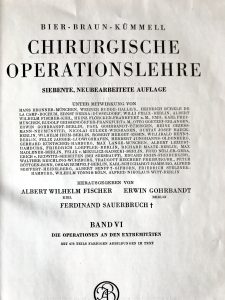
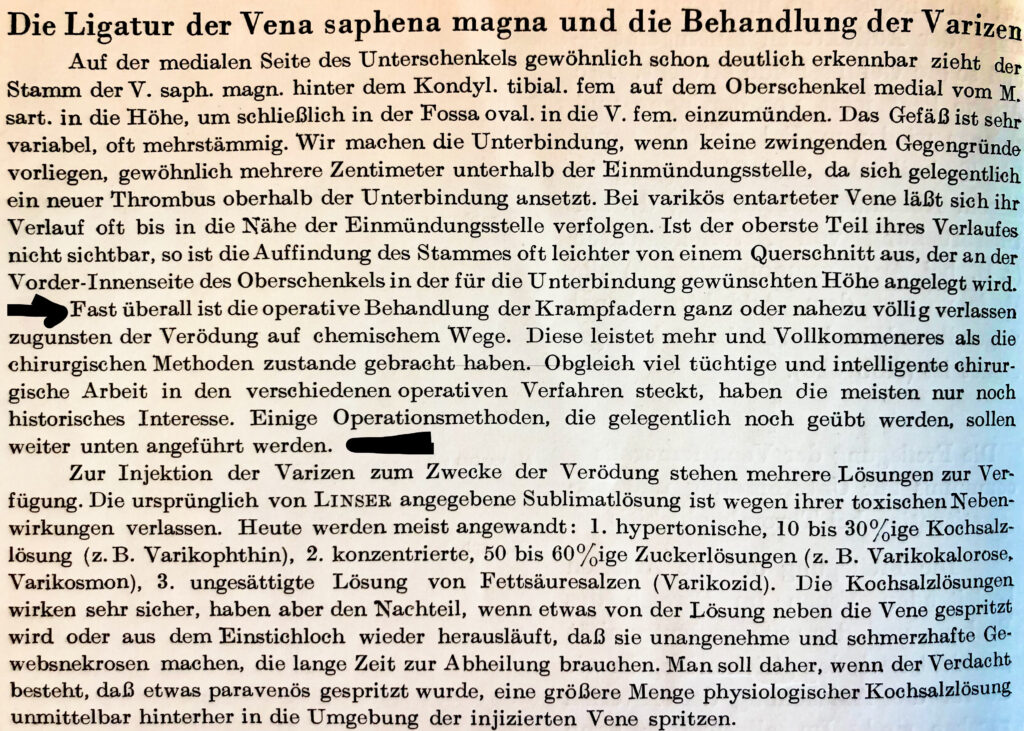
Saphenion®: memories of Sauerbruch – déjà-v
As I read our literature sources and observed our daily work, I felt more and more that, despite all the differences in time, surgical ability, and scientific expertise, our approach and our absolute decision towards gentler therapy had similar reasons was owed, as at the time with Sauerbruch. And this is my little, very personal déjà-vu, which surprised me so much while researching the medical history and writing our little booklet. And it keeps me captive to this day and influences my daily work with and on our patients.
This closes this small circle with the great surgeon Ferdinand Sauerbruch.
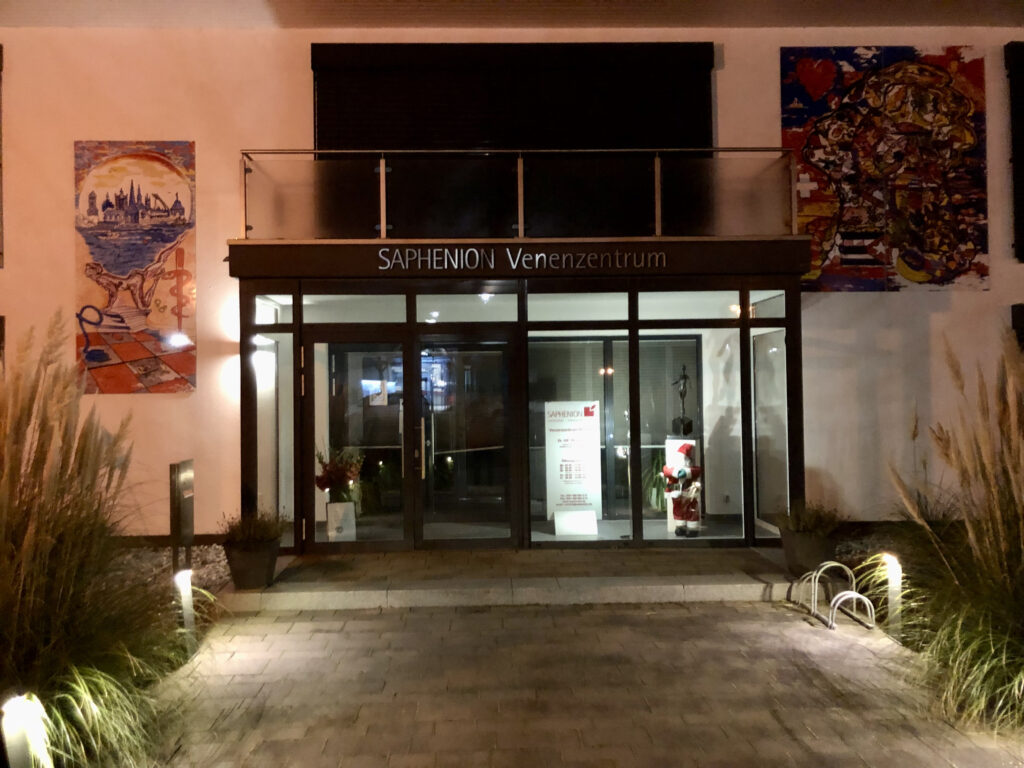
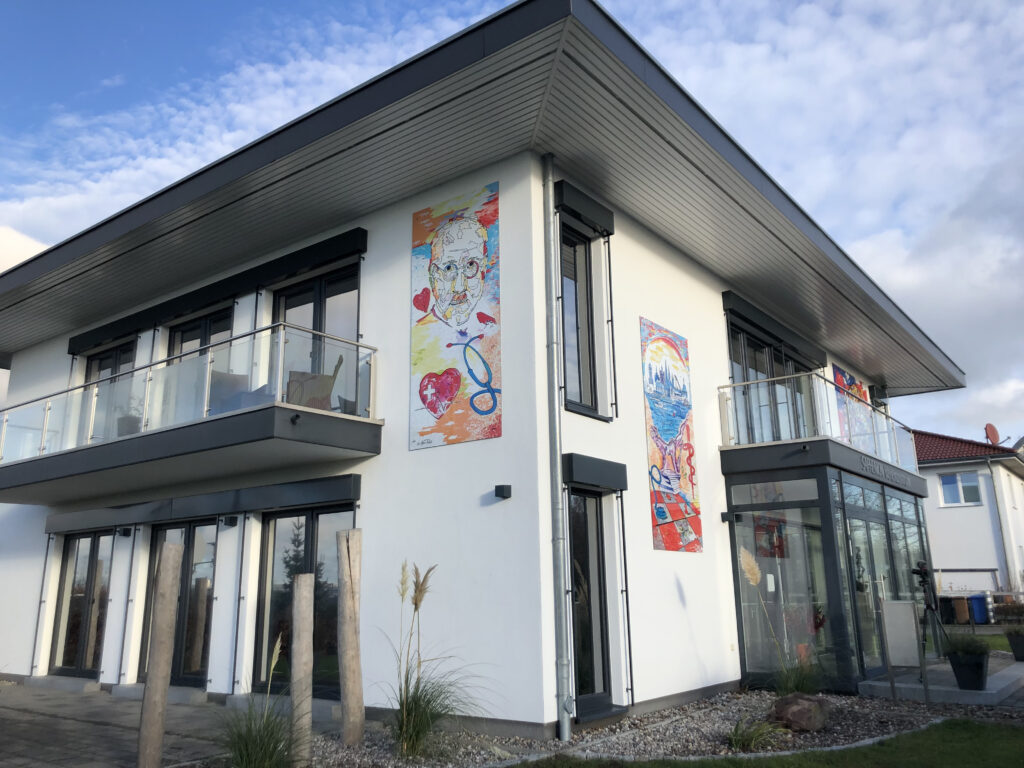
Saphenion®: Memories of Sauerbruch – Sauerbruch in Nazi Socialism
After his acquittal before the denazification committee in 1946, Ferdinand Sauerbruch became an extremely honored German surgeon for many decades. But from 2009 the FRG perspective changed, increasing its role in the 3rd Reich moved into the focus of consideration. He was described as a tolerator and supporter of the Nazis, and it began with a book by Geralf Gemser. In 2016 Wolfgang Eckart wrote a general settlement with Sauerbruch. In 2018 the “Tagesspiegel” headlined: Sauerbruch and Bonhoeffer went: Activists cover streets named after Nazi perpetrators and demand more commitment from the Charitè. „
In a book by Christian Hardinghaus, „Ferdinand Sauerbruch and the Charitè – Operations against Hitler“, which was published recently in 2021, all the connections between Sauerbruch and the 3rd Reich that have been claimed for 13 years are cleared up and, using new sources, the image of one of the most famous German surgeons is straightened out again moved. Reading this paperback gave us the final impetus for our article and also the facade design of our Rostock practice.
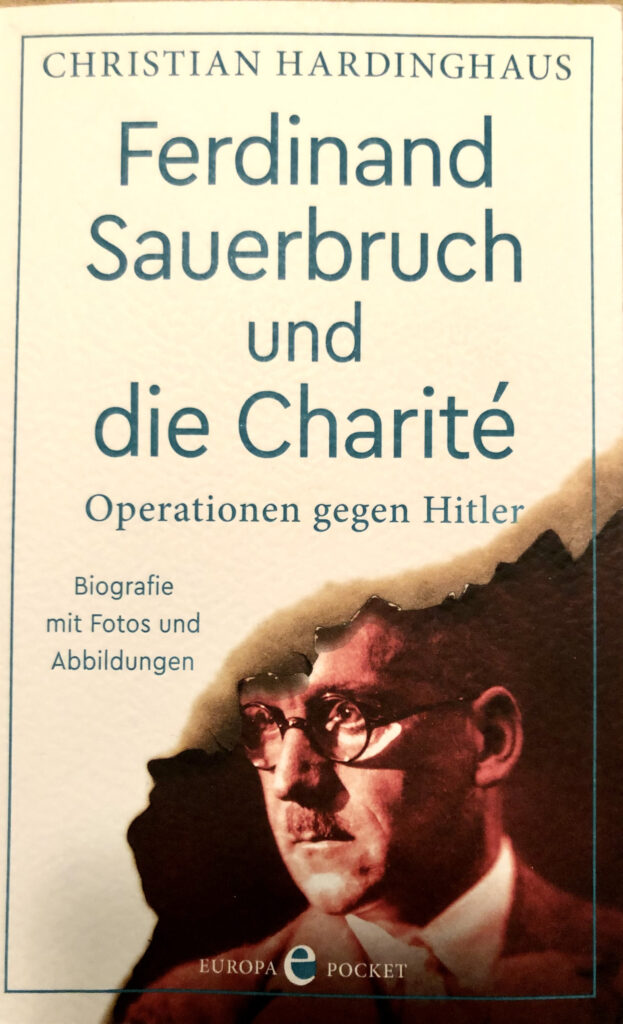
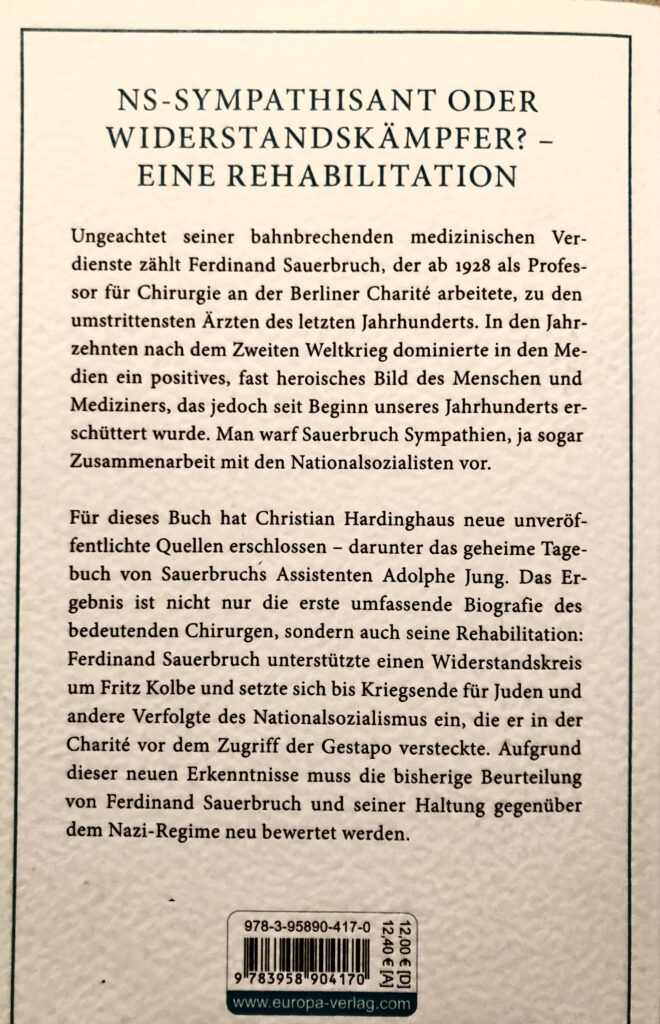
Photos: Utzius
Papers / Links:
Brungräber, Simone: „Der Beitrag Berliner Chirurgen zur Entwicklung der deutschen und europäischen Gefäßchirurgie bis 1939“- Dissertation A, vorgelegt der Medizinischen Fakultät der Humboldt Universität zu Berlin; 1/1995; Betreuer Prof. Dr. Klaus Bürger, Dr. Ulf Th.Zierau
Baur, Carl Josef: Berliner Medizinische Gesellschaft; 23.1.1935; Dtsch. Med. Wschr. 61; (1935); S. 403;
Baur, C. J.: Krampfaderverödung bei Ulcus cruris. Dtsch Med. Wschr.: 60 ( 1934); S. 761.
Baur, C.J.: Krampfaderverödung: Ihre Bedeutung für Wehrmacht und Krankenkassen. Münchner Med. Wschr. 88 (1941); S. 89 – 92.
Bier, Braun, Kümmell: Chirurgische Operationslehre, 7. Auflage, J.A. Barth, Leipzig, 1958
Bierendempfel: Über die Bedeutung des Injektionsverfahrens bei der Varizenbehandlung mit Berücksichtigung des “ Varicophtins“; Dtsch.. Med. Wschr.: 53; (1927) S. 446 – 448.
Biographisches Lexikon hervorragender Ärzte des 19. JH.; Urban & Schwarzenberg; 1901
Deutsches Chirurgenverzeichnis; 3. Auflage; Johann Ambrosius Barth; Leipzig, 1938
Eckart, Wolfgang U.: Ferdinand Sauerbruch – Meisterchirurg im politischen Sturm. Eine kompakte Biographie für Ärzte und Patienten, Wiesbaden 2016
Gemser, Geralf: „Unsere Namensgeber“. Widerstand, Verfolgung und Konformität 1933-1945 im Spiegelbild heutiger Schulnamen, München 2009
Genschoreck, W.: Ferdinand Sauerbruch – ein Leben für die Chirurgie; S.Hirzel Verlag Leipzig, 1978.
Hach, W. et al.: VenenChirurgie; Schattauer Verlag Stuttgart, 2006.
Hardinghaus, C.: Ferdinand Sauerbruch und die Charitè – Operationen gegen Hitler; Europa Verlage GmbH, München; 2021.
Leriche, Renè: Chirurgie des Schmerzes; J.A.Barth, Leipzig, 1958:
Linser, P.: Krampfaderverödungen; Zbl. Gyn. 1931; Nr. 17.
Meyer-Steinegg, Th. und Sudhoff, Karl: Geschichte der Medizin im Überblick mit Abbildungen; Verlag von Gustav Fischer, Jena 1928.
Meyer, F. G.: Über Varizenbehandlung mit den Linser`schen Sublimatinjektionen; Dtsch. Med. Wschr. 50 (1924); S. 1832 f.
Salomon,A.: Injektionsbehandlung der Krampfadern. Dtsch. Med.. Wschr. 54; 1928; S14-19
Sauerbruch, Ferdinand: Das war mein Leben. Bad Wörishofen 1951.
Stoeckel, Walter: Erinnerungen eines Frauenarztes, Leipzig 1979.
Weber,J. und May, R.: Funktionelle Phlebologie; G. Thieme Verlag Stuttgart, New York 1990.
Wresszynski, E.: Zur Verödungstherapie der Varizen mit sklerosierenden Injektionen. Etsch. Med. Wschr.; 55 (1929); S 791 f.
Zierau, U.Th. und Lahl. W.: The fate of „Saphena“ – Views into the past (extended version); LAP Lambert Academic Publishing; 2020.
Zierau U. Th.: Brungräber, S.: Das gefäßchirurgische Erbe: Die Entwicklung Berlins zu einem Zentrum gefäßchirurgischer Forschung in Europa im Zeitraum von 1880 – 1930. angio 16 (1994); Nr. 3; S. 93 – 105
https://de.wikipedia.org/wiki/Walter_Schmitt_(Mediziner,_1911)
http://cpr.uni-rostock.de/resolve/id/cpr_person_00002690
https://www.thieme-connect.com/products/ejournals/abstract/10.1055/s-0031-1271565
https://de.wikipedia.org/wiki/Friedrich_Trendelenburg_(Mediziner,_1844)
http://cpr.uni-rostock.de/resolve/id/cpr_person_00002480
https://de.wikipedia.org/wiki/Trendelenburg-Operation_bei_Krampfaderleiden
